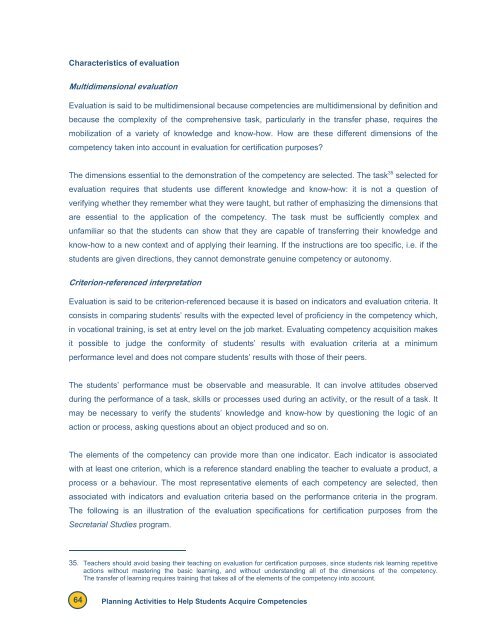Reference Framework for Planning Learning and Evaluation Activities
Reference Framework for Planning Learning and Evaluation Activities
Reference Framework for Planning Learning and Evaluation Activities
You also want an ePaper? Increase the reach of your titles
YUMPU automatically turns print PDFs into web optimized ePapers that Google loves.
Characteristics of evaluation<br />
Multidimensional evaluation<br />
<strong>Evaluation</strong> is said to be multidimensional because competencies are multidimensional by definition <strong>and</strong><br />
because the complexity of the comprehensive task, particularly in the transfer phase, requires the<br />
mobilization of a variety of knowledge <strong>and</strong> know-how. How are these different dimensions of the<br />
competency taken into account in evaluation <strong>for</strong> certification purposes<br />
The dimensions essential to the demonstration of the competency are selected. The task 35 selected <strong>for</strong><br />
evaluation requires that students use different knowledge <strong>and</strong> know-how: it is not a question of<br />
verifying whether they remember what they were taught, but rather of emphasizing the dimensions that<br />
are essential to the application of the competency. The task must be sufficiently complex <strong>and</strong><br />
unfamiliar so that the students can show that they are capable of transferring their knowledge <strong>and</strong><br />
know-how to a new context <strong>and</strong> of applying their learning. If the instructions are too specific, i.e. if the<br />
students are given directions, they cannot demonstrate genuine competency or autonomy.<br />
Criterion-referenced interpretation<br />
<strong>Evaluation</strong> is said to be criterion-referenced because it is based on indicators <strong>and</strong> evaluation criteria. It<br />
consists in comparing students’ results with the expected level of proficiency in the competency which,<br />
in vocational training, is set at entry level on the job market. Evaluating competency acquisition makes<br />
it possible to judge the con<strong>for</strong>mity of students’ results with evaluation criteria at a minimum<br />
per<strong>for</strong>mance level <strong>and</strong> does not compare students’ results with those of their peers.<br />
The students’ per<strong>for</strong>mance must be observable <strong>and</strong> measurable. It can involve attitudes observed<br />
during the per<strong>for</strong>mance of a task, skills or processes used during an activity, or the result of a task. It<br />
may be necessary to verify the students’ knowledge <strong>and</strong> know-how by questioning the logic of an<br />
action or process, asking questions about an object produced <strong>and</strong> so on.<br />
The elements of the competency can provide more than one indicator. Each indicator is associated<br />
with at least one criterion, which is a reference st<strong>and</strong>ard enabling the teacher to evaluate a product, a<br />
process or a behaviour. The most representative elements of each competency are selected, then<br />
associated with indicators <strong>and</strong> evaluation criteria based on the per<strong>for</strong>mance criteria in the program.<br />
The following is an illustration of the evaluation specifications <strong>for</strong> certification purposes from the<br />
Secretarial Studies program.<br />
35. Teachers should avoid basing their teaching on evaluation <strong>for</strong> certification purposes, since students risk learning repetitive<br />
actions without mastering the basic learning, <strong>and</strong> without underst<strong>and</strong>ing all of the dimensions of the competency.<br />
The transfer of learning requires training that takes all of the elements of the competency into account.<br />
64 <strong>Planning</strong> <strong>Activities</strong> to Help Students Acquire Competencies




